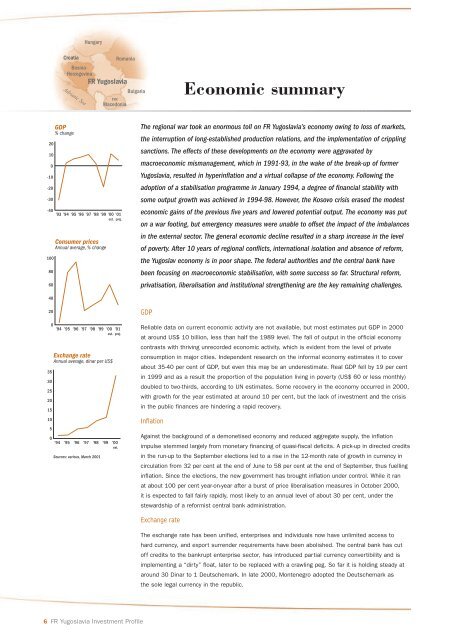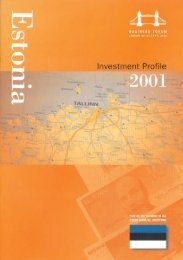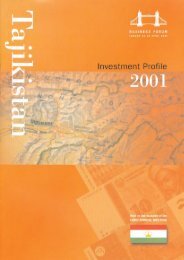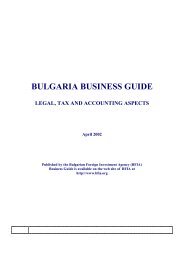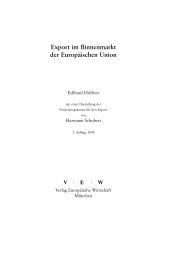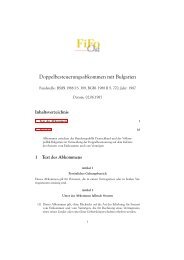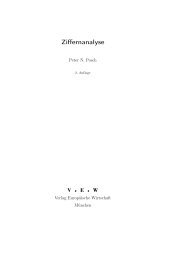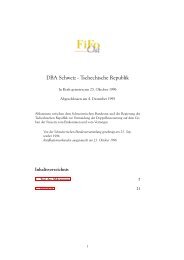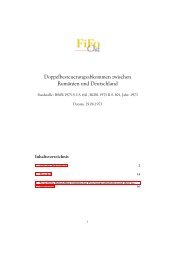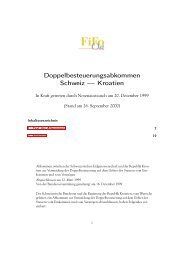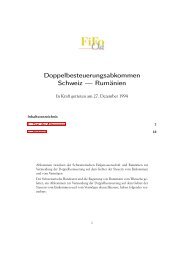4820 FR Yugoslavia - FiFo Ost
4820 FR Yugoslavia - FiFo Ost
4820 FR Yugoslavia - FiFo Ost
You also want an ePaper? Increase the reach of your titles
YUMPU automatically turns print PDFs into web optimized ePapers that Google loves.
20<br />
10<br />
0<br />
-10<br />
-20<br />
-30<br />
Hungary<br />
Croatia<br />
Bosnia-<br />
Herzegovina<br />
Adriatic Sea<br />
Romania<br />
<strong>FR</strong> <strong>Yugoslavia</strong><br />
FYR<br />
Macedonia<br />
-40<br />
’93 ’94 ’95 ’96 ’97 ’98 ’99 ’00 ’01<br />
est. proj.<br />
100<br />
80<br />
60<br />
40<br />
20<br />
GDP<br />
% change<br />
0<br />
’94 ’95 ’96 ’97 ’98 ’99 ’00 ’01<br />
est. proj.<br />
35<br />
30<br />
25<br />
20<br />
15<br />
10<br />
5<br />
Consumer prices<br />
Annual average, % change<br />
Exchange rate<br />
Annual average, dinar per US$<br />
0<br />
’94 ’95 ’96 ’97 ’98 ’99 ’00<br />
est.<br />
Sources: various, March 2001<br />
Bulgaria<br />
6 <strong>FR</strong> <strong>Yugoslavia</strong> Investment Profile<br />
Economic summary<br />
The regional war took an enormous toll on <strong>FR</strong> <strong>Yugoslavia</strong>’s economy owing to loss of markets,<br />
the interruption of long-established production relations, and the implementation of crippling<br />
sanctions. The effects of these developments on the economy were aggravated by<br />
macroeconomic mismanagement, which in 1991-93, in the wake of the break-up of former<br />
<strong>Yugoslavia</strong>, resulted in hyperinflation and a virtual collapse of the economy. Following the<br />
adoption of a stabilisation programme in January 1994, a degree of financial stability with<br />
some output growth was achieved in 1994-98. However, the Kosovo crisis erased the modest<br />
economic gains of the previous five years and lowered potential output. The economy was put<br />
on a war footing, but emergency measures were unable to offset the impact of the imbalances<br />
in the external sector. The general economic decline resulted in a sharp increase in the level<br />
of poverty. After 10 years of regional conflicts, international isolation and absence of reform,<br />
the Yugoslav economy is in poor shape. The federal authorities and the central bank have<br />
been focusing on macroeconomic stabilisation, with some success so far. Structural reform,<br />
privatisation, liberalisation and institutional strengthening are the key remaining challenges.<br />
GDP<br />
Reliable data on current economic activity are not available, but most estimates put GDP in 2000<br />
at around US$ 10 billion, less than half the 1989 level. The fall of output in the official economy<br />
contrasts with thriving unrecorded economic activity, which is evident from the level of private<br />
consumption in major cities. Independent research on the informal economy estimates it to cover<br />
about 35-40 per cent of GDP, but even this may be an underestimate. Real GDP fell by 19 per cent<br />
in 1999 and as a result the proportion of the population living in poverty (US$ 60 or less monthly)<br />
doubled to two-thirds, according to UN estimates. Some recovery in the economy occurred in 2000,<br />
with growth for the year estimated at around 10 per cent, but the lack of investment and the crisis<br />
in the public finances are hindering a rapid recovery.<br />
Inflation<br />
Against the background of a demonetised economy and reduced aggregate supply, the inflation<br />
impulse stemmed largely from monetary financing of quasi-fiscal deficits. A pick-up in directed credits<br />
in the run-up to the September elections led to a rise in the 12-month rate of growth in currency in<br />
circulation from 32 per cent at the end of June to 58 per cent at the end of September, thus fuelling<br />
inflation. Since the elections, the new government has brought inflation under control. While it ran<br />
at about 100 per cent year-on-year after a burst of price liberalisation measures in October 2000,<br />
it is expected to fall fairly rapidly, most likely to an annual level of about 30 per cent, under the<br />
stewardship of a reformist central bank administration.<br />
Exchange rate<br />
The exchange rate has been unified, enterprises and individuals now have unlimited access to<br />
hard currency, and export surrender requirements have been abolished. The central bank has cut<br />
off credits to the bankrupt enterprise sector, has introduced partial currency convertibility and is<br />
implementing a “dirty” float, later to be replaced with a crawling peg. So far it is holding steady at<br />
around 30 Dinar to 1 Deutschemark. In late 2000, Montenegro adopted the Deutschemark as<br />
the sole legal currency in the republic.


